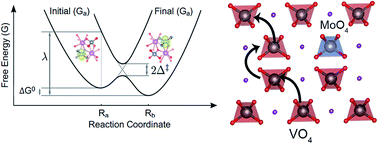Combining Landau–Zener theory and kinetic Monte Carlo sampling for small polaron mobility of doped BiVO4 from first-principles†
Abstract
Transition metal oxides such as BiVO4 are promising photoelectrode materials for solar-to-fuel conversion applications. However, their performance is limited by the low carrier mobility (especially electron mobility) due to the formation of small polarons. Recent experimental studies have shown improved carrier mobility and conductivity by atomic doping; however the underlying mechanism is not understood. A fundamental atomistic-level understanding of the effects on small polaron transport is critical to future material design with high conductivity. We studied the small polaron hopping mobility in pristine and doped BiVO4 by combining Landau–Zener theory and kinetic Monte Carlo (kMC) simulation fully from first-principles, and investigated the effect of dopant–polaron interactions on the mobility. We found that polarons are spontaneously formed at V in both pristine and Mo/W doped BiVO4, which can only be described correctly by density functional theory (DFT) with the Hubbard correction (DFT+U) or hybrid exchange-correlation functional but not local or semi-local functionals. We found that DFT+U and dielectric dependant hybrid (DDH) functionals give similar electron hopping barriers, which are also similar between the room temperature monoclinic phase and the tetragonal phase. The calculated electron mobility agrees well with experimental values, which is around 10−4 cm2 V−1 s−1. We found that the electron polaron transport in BiVO4 is neither fully adiabatic nor nonadiabatic, and the first and second nearest neighbor hoppings have significantly different electronic couplings between two hopping centers that lead to different adiabaticity and prefactors in the charge transfer rate, although they have similar hopping barriers. Without considering the detailed adiabaticity through Landau–Zener theory, one may get qualitatively wrong carrier mobility. We further computed polaron mobility in the presence of different dopants and showed that Cr substitution of V is an electron trap while Mo and W are “repulsive” centers, mainly due to the minimization of local lattice expansion by dopants and electron polarons. The dopants with “repulsive” interactions to polarons are promising for mobility improvement due to larger wavefunction overlap and delocalization of locally concentrated polarons.



 Please wait while we load your content...
Please wait while we load your content...